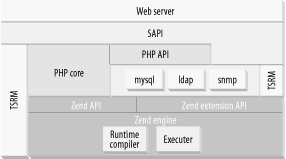14.1 Architectural Overview
| There are two kinds of extensions that you can write: PHP extensions and Zend extensions. We will focus on PHP extensions here. Zend extensions are lower-level extensions that somehow modify the very core of the language. Opcode cache systems such as APC, Bware afterBurner, and ZendCache are Zend extensions. PHP extensions simply provide functions or objects to PHP scripts. MySQL, Oracle, LDAP, SNMP, EXIF, GD, and ming are all examples of PHP extensions. Figure 14-1 shows a diagram of a web server with PHP linked in. The web server layer at the top handles incoming HTTP requests and passes them to PHP via the Server Abstraction API (SAPI). The "mysql", "ldap", and "snmp" boxes represent loadable PHP extensions, the kind you'll learn how to build in this chapter. TSRM is the Thread Safe Resource Manager layer, which helps simplify thread-safe programming. The PHP Core contains many of the nonoptional core features of PHP, and the PHP API contains the PHP-specific API functions used by both the core and the PHP extensions. Finally, there is the Zend engine, which runs scripts through a two-pass mechanism, first generating a set of opcodes and then executing them. A PHP extension uses the Zend extension API to receive arguments from function calls and return values back. Figure 14-1. Structure of a PHP-linked web server |
EAN: 2147483647
Pages: 168
- Integration Strategies and Tactics for Information Technology Governance
- An Emerging Strategy for E-Business IT Governance
- Measuring and Managing E-Business Initiatives Through the Balanced Scorecard
- A View on Knowledge Management: Utilizing a Balanced Scorecard Methodology for Analyzing Knowledge Metrics
- Governing Information Technology Through COBIT